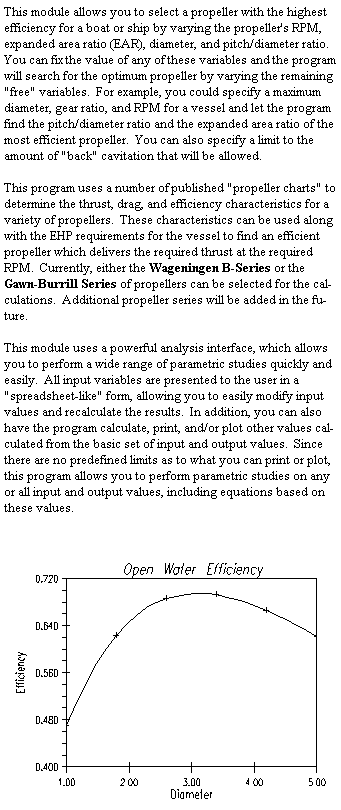| |
|
|
|
|
|
|
|
|
|
|
|
|
|
|
|
|
|
|
|
|
|
|
| |
|
| |
|
|
| |
Planing Boat
Resistance
(Long Form)
|
|
| |
|
|
|
|
| |
|
| |
|
| |
|
|
| |
This module
calculates the resistance of planing
boats in both displacement and planing
modes. Planing mode uses a
variation of Savitsky's "long
form" calculations, taking into
account factors such as skegs, rudders,
trim tabs, wave heights, and air
resistance. Displacement mode uses
a regression technique, developed by
Savitsky and Brown, which determines
resistance for Froude numbers between 1.0
and 2.0.
This module uses a powerful analysis
interface, which allows you to perform a
wide range of parametric studies quickly
and easily. First, all input
variables are presented in a
"spreadsheet-like" form,
allowing you to easily modify input
values and recalculate the results.
In addition, you can have the program
calculate, print, and/or plot other
values calculated from the basic set of
input and output values. For
example, you can request that the value
of resistance/weight be plotted against
Froude number, or resistance plotted
against deadrise angle. Since there
are no predefined limits as to what you
can print or plot, this program allows
you to perform parametric studies on any
or all input and output values, including
equations based on these values.
|
|
| |
|
|
|
|
| |
|
| |
|
 |
|
| |
|
| |
|
|
| |
The planing boat
program uses input such as beam, draft,
and deadrise angle to perform all of its
calculations. You do not need an
exact description of the hull to perform
these calculations. The results are
printed in report format and list all
input, results, and intermediate values,
to allow you to verify or check any
answer.
Displacement
Mode - Displacement
mode calculates the smooth water
(non-planing) resistance of a
vessel. This technique can be used
to calculate resistance for Froude
numbers (volume) less than 2.0. It
is based on a regression analysis of a
wide range of hull forms and uses the
method described in:
|
|
| |
|
|
|
|
| |
|
| |
|
| |
|
|
| |
"Procedures
for Hydrodynamic Evaluation of Planing
Hulls in Smooth and Rough Water"
Daniel Savitsky and P. Ward Brown
Marine Technology, October, 1976
|
|
| |
|
|
|
|
| |
|
| |
|
 |
|
| |
|
| |
|
| |
|
|
| |
Planing Mode - For
planing mode, a group of equilibrium
equations are used to describe the vessel
moving at a steady rate. These
equations cover a variety of lift and
drag forces, such as hull normal force,
friction drag, and spray drag. Once
the input is specified, these equations
are solved to find the resistance and
trim of the vessel. Eight pages of
input and output can be printed or
plotted to allow you to perform detailed
optimizations.
The procedure for
defining the system of equilibrium
equations and hull drag and lift forces
is derived from:
"Hydrodynamic
Design of Planing Hulls"
Daniel Savitsky
Marine Technology, October, 1964
Additional
equations covering appendages, air
resistances, and added resistance due to
waves came from a variety of other
sources. Contact New Wave Systems,
Inc. for a complete list of references
used and a complete set of equations
used.
|
|
| |
|
|
|
|
| |
|
 |
|
| |
|
| |
|
 |
|
| |
|
| |
|
| |
|
|
| |
Planing Boat
Resistance
(Short Form)
|
|
| |
|
|
|
|
| |
|
| |
|
| |
|
|
| |
This module
calculates the resistance of chine hull
boats in the planing condition. It
uses a powerful analysis interface, which
allows you to perform a wide range of
parametric studies quickly and
easily. You may calculate results
for a single condition or you may print
or plot results over a range of values.
Calculation of the vessel's resistance,
EHP, and trim are done assuming that all
forces pass through the center of gravity
(LCG). The technique used is one
described in:
"Hydrodynamic Design of Planing
Hulls"
Daniel Savitsky
Marine Technology, Vol 1, No. 1
Oct. 1964
It is often referred to as the
"short form" calculation due to
the simplification of having all forces
pass through the center of gravity.
In addition to calculating the bare-hull
resistance, this program accounts for
appendage drag and wave drag.
Another reference about this technique
is:
"Small-Craft Power Prediction"
Blount and Fox
Marine Technology, Vol. 13, No. 1
January, 1976.
Vk Tau
Taucrit Rbh
Rt
EHP
10.00
3.7196 17.2000 2296.00
3035.34
93.13
12.00 4.0625
19.5440 4414.62
5402.15 198.91
14.00 4.4634
18.1383 5668.45
6864.27 294.87
16.00 4.8833
15.9557 6421.19
7803.00 383.08
18.00 5.2459
13.8334 6836.13
8388.89 463.33
20.00 5.4720
11.9866 6992.83
8704.18 534.16
22.00 5.5307
10.4395 6967.70
8828.20 595.95
24.00 5.4462
9.1604 6844.11
8848.57 651.62
26.00 5.2644
8.1058 6689.49
8836.85 704.99
28.00 5.0280
7.2349 6545.81
8838.06 759.33
30.00 4.7667
6.5128 6433.78
8874.84 816.95
32.00 4.5004
5.9113 6362.16
8957.23 879.50
34.00 4.2403
5.4076 6332.75
9087.86 948.10
36.00 3.9927
4.9837 6344.34
9266.16 1023.57
38.00 3.7604
4.6253 6394.49
9490.23 1106.56
40.00 3.5444
4.3207 6480.46
9757.88 1197.65
Example of Looping Output
|
|
| |
|
|
|
|
| |
|
| |
|
 |
|
| |
|
| |
|
| |
|
|
| |
All input
variables are presented to you in a
spreadsheet-like form, allowing you to
easily modify their values and
recalculate the results. In
addition, you can also have the program
calculate, print, and/or plot other
values derived from the basic set of
input and output values. For
example, you can request that the value
of resistance/weight be plotted against
Froude number, or resistance plotted
against deadrise angle. Since there
are no predefined limits as to what you
can print or plot, this technique allows
you to perform parametric studies on any
or all input and output values, including
equations based on these values.
There are 39 input and output variables
which can be used to perform looping and
plotting. All of these variables
can be displayed, printed, or plotted,
along with any algebraic combinations of
these variables.
|
|
| |
|
|
|
|
| |
|
| |
|
 |
|
| |
|
| |
 |
|
| |
|
| |
|
| |
|
|
| |
Propeller
Selection and Optimization
|
|
| |
|
|
|
|
| |
|
| |
|
 |
|
| |
|
| |
|
| |
|
|
| |
This propeller
module allows you to approach the problem
of propeller selection from various
directions:
1. If all of the initial data is known,
(Diameter(D), RPM(N), pitch/diameter
ratio(P/D), and expanded area
ratio(EAR)), then you can directly
calculate the various quantities related
to the propeller, such as thrust and
torque delivered, along with the open
water efficiency of the propeller.
2. Given that one of the quantities from
the input group: D,P/D,EAR,N, is missing
then the missing value can be found such
that the thrust delivered matches the
thrust required. The required
thrust is determined from the input EHP
values. No optimization is done
since the one "free" variable
is used to match the delivered thrust
with the required thrust for the
specified velocity.
3. An optimum propeller (with the highest
open water efficiency) can be found if
two or more values from the group (D,
P/D, EAR, N) are not entered as input.
For example, a design process might
proceed as follows:
o Enter the maximum allowed diameter.
o Optimize to determine the EAR, N, and
P/D of the optimum propeller.
o Use the resultant SHP and N to select
an engine and reduction gear ratio.
o Optimize again using the same diameter
and the actual
N = N(rpm of engine)/GR (gear ratio).
o Use the resultant P/D and EAR to select
a few candidate propellers.
o Compare the candidate propellers at all
design and off-design conditions.
Compare how their efficiencies drop off
due to increased resistance (from
fouling) or when the RPMs are increased
over the design condition.
4. The module also allows you to loop
(print) or plot anything vs. anything
else. For example, you could print
or plot efficiency vs RPM (N) or thrust
delivered minus thrust required (Tdel -
Treq) vs RPM for a given value of
diameter. The "loop"ing
function allows you to display or print
these values and the "plot"ting
option allows you to display or plot the
graph of the values.
|
|
| |
|
|
|
|
| |
|





